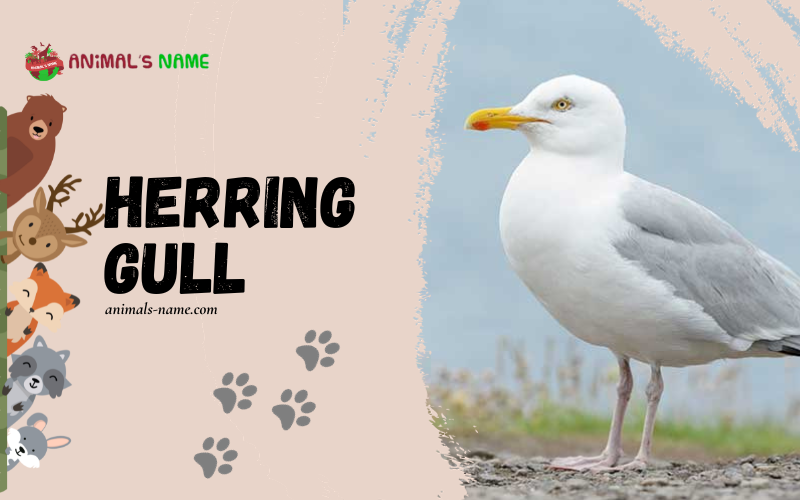Birds are fascinating creatures that come in all shapes and sizes. In this blog post, we will be delving into the world of the Herring Gull, one of the most well-known and widely distributed birds worldwide. The Herring Gull, scientifically known as Larus argentatus, has a rich history and many interesting facts, making it the perfect subject for our discussion.
Herring Gulls are large birds, usually measuring around 55-66 centimetres long and weighing between 1-1.5 kilograms. Their wingspan can reach an impressive 144-166 centimetres. They have a distinct appearance: white plumage, grey back, and a yellow beak with a red spot at the tip. These gulls are known for their loud and distinctive calls, often associated with coastal areas.
As for their habitat, Herring Gulls are highly adaptable birds found near coasts, beaches, cliffs, and even inland areas such as lakes and rivers. They have a wide distribution range, including North America, Europe, and Asia. Herring Gulls are opportunistic feeders known to scavenge for food, consuming various items like fish, insects, small mammals, and even garbage.
The Herring Gull is a remarkable bird with a fascinating history and many intriguing facts. Its large size, distinct appearance, and adaptable nature make it a common sight in coastal areas worldwide. Stay tuned for more exciting blog posts about other incredible animals’ names, as we already have an article covering over 155 animals.
History of Herring Gull

The Herring Gull is a bird found in many parts of the world, including North America, Europe, and Asia. These birds are known for their distinctive appearance and ability to adapt to various environments. Herring Gulls are considered to be large seabirds with a wingspan that can reach up to 5 feet. They have a white head and body, grey wings, and yellow beaks. Additionally, they have strong and sharp claws that help them catch food.
The history of the Herring Gull can be traced back thousands of years. Fossils of similar species dating back over 15 million years have been discovered. These birds have survived and thrived in different habitats, from coastal areas to inland lakes. They are highly adaptable and can live in various environments, including cities, farmland, and garbage dumps.
Herring Gulls are opportunistic feeders, which means they can consume a wide range of food sources. They mainly eat fish, insects, small mammals, eggs, and even garbage. This adaptability has contributed to their success in different habitats and has allowed them to survive and reproduce throughout generations.
The Herring Gull is a remarkable bird with a long history and successfully adapted to various environments. Their ability to survive in different habitats and their opportunistic feeding habits have enabled them to thrive and populate many parts of the world. As one of the most common species of gulls, the Herring Gull continues to captivate the attention of bird enthusiasts and scientists alike.
Importance of Herring Gull

Herring Gull birds are essential for our environment. They play a crucial role in the ecosystem by helping to control the population of smaller animals and insects. These birds like to eat small fish, insects and even garbage that they find near the shore. By doing this, they help maintain a balance in nature by keeping the population of these creatures in check.
Another reason why herring gulls are essential is because they help to spread seeds. When they eat fruits and berries, they sometimes drop the seeds in different areas as they fly around. This allows the plants to grow elsewhere, making the ecosystem more diverse and resilient.
Herring Gull birds are also indicators of the health of our environment. If their population decreases, it could indicate something is wrong with the ecosystem. This could be due to pollution, overfishing, or habitat destruction. Therefore, by monitoring the population of herring gulls, scientists can ensure the health and balance of our environment.
Herring gull birds are essential for our environment because they help control the population of smaller animals and insects, spread seeds to promote a diverse ecosystem and act as indicators of environmental health. We must value and protect these birds to maintain a healthy and balanced environment for all living creatures.
Amazing Facts About Herring Gull
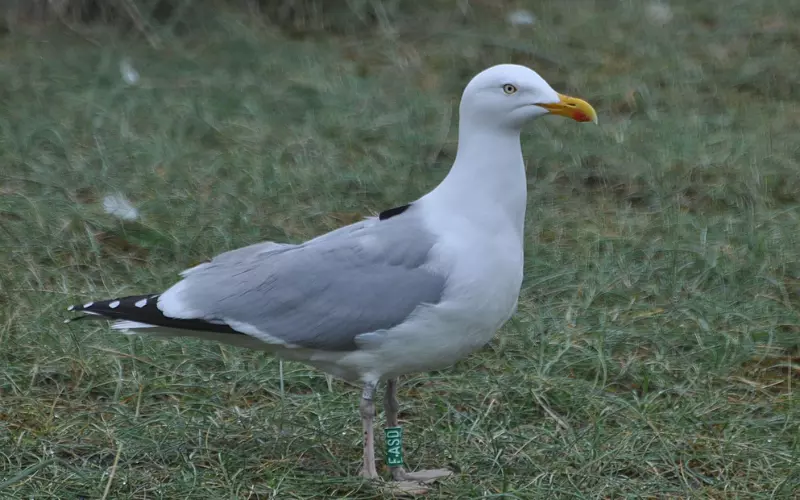
1. Herring gulls are large birds that belong to the gull family and are found in many countries worldwide.
2. These birds are known for their white and grey feathers, with adults having yellow bills and legs.
3. Herring gulls are highly adaptable and can be found in various habitats, including coastal areas, lakes, and urban areas.
4. They are primarily scavengers and feed on a wide range of food, including fish, small mammals, insects, and even garbage.
5. These birds are known to steal food from other birds and even people if given the opportunity.
6. Herring gulls are excellent fliers and can soar long distances using wind currents and thermals.
7. They are social birds and often gather in large colonies, especially during breeding season.
8. Herring gulls build their nests on the ground or low cliffs using twigs, grass, and other materials they find in their environment.
9. The female lays two to three eggs, which both parents take turns incubating for about 25 to 28 days until they hatch.
10. Herring gull chicks are covered in greyish-brown down when they hatch and are entirely dependent on their parents for food and care.
11. These birds are known for their loud and distinctive “laughing” call, often heard near coastal areas.
12. Herring gulls have a lifespan of around 20 to 30 years in the wild, although some individuals have been known to live longer.
13. They are brilliant birds and have been observed using tools, such as dropping shells from high heights to break them open.
14. Herring gulls are migratory birds and can cover long distances during their seasonal migrations.
15. Unfortunately, the herring gull population has declined in some areas due to habitat loss, pollution, and human disturbance. It is essential to protect their habitats and help conserve these fascinating birds.
Can we keep Herring Gull as our Pet?
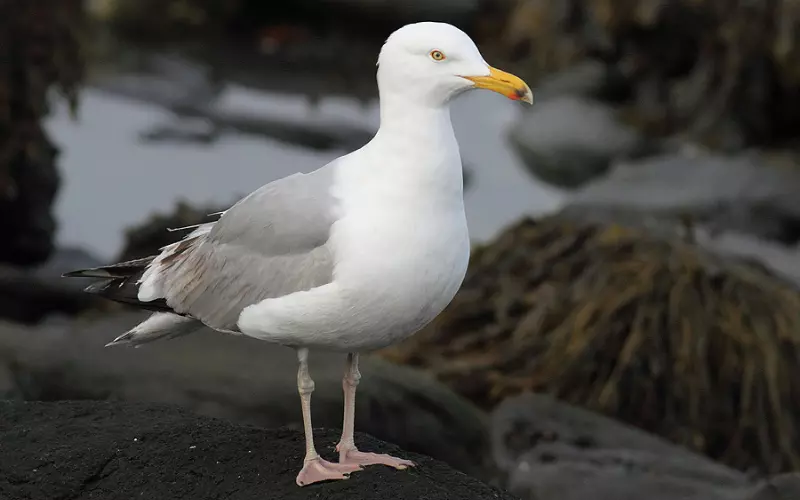
We cannot keep Herring Gull birds as pets. These birds are not suitable for living in our homes because they belong to the wild. They need an open and natural environment to fly freely and find food. Like other wild animals, keeping them in cages as pets is unfair.
Herring Gulls are enormous and magnificent birds known for their grey and white feathers. However, it is essential to understand that they are wild animals and should remain in their natural habitats. Trying to keep them as pets can cause them stress and harm. They must fly high in the sky and feel the wind beneath their wings.
Unfortunately, Herring Gulls also face another challenge – extinction. Due to factors like habitat destruction, pollution, and hunting, their numbers are decreasing rapidly. If these birds become extinct, they will no longer exist worldwide. This is a tragedy because every living creature plays a vital role in maintaining the balance of our ecosystem. Therefore, we are responsible for protecting and allowing these fantastic birds to live freely in their natural habitats rather than keeping them as pets.
Herring Gull birds should not be kept as pets. They are wild animals who need their freedom, and keeping them in cages can cause them harm. Additionally, we must work towards protecting these birds from extinction by preserving their natural habitats and minimizing our impact on their environment. Let’s admire and respect them from a distance and allow them to live as nature intended.
Size of Herring Gull

The Herring Gull is a large bird in many parts of the world. It is one of the giant gull species, measuring 22-26 inches long and having a wingspan of about 4.5-5 feet. If you can imagine, that’s about the size of a medium-sized dog!
These gulls have sturdy and robust bodies, which allow them to survive in different environments. They have a white head, neck, underparts, grey wings and back. Their strong beak is yellow with a red spot, making it easy to spot them from far away.
While the males and females look pretty similar, the males are usually larger and heavier. The adult Herring Gulls can weigh around 2-3 pounds, almost as serious as a small laptop. They use their long wings to soar high in the sky, often gliding effortlessly above the water to find food. Their legs are pale pink, and their webbed feet allow them to swim quickly.
Herring Gulls are notable for their large size, with an average length of 22-26 inches and a wingspan of about 4.5-5 feet. These gulls have a sturdy build, white heads and underparts, grey wings, and a solid yellow beak with a red spot. The males are generally bigger, weighing around 2-3 pounds. With their long wings and webbed feet, Herring Gulls are excellent fliers and swimmers.
Habitat of Herring Gull

The Herring Gull bird is quite a common sight along the coastlines of North America, Europe, and Asia. It is often found near the sea, making its habitat along rocky cliffs and sandy beaches. These birds are well adapted to life on the coast, with their strong wings allowing them to fly effortlessly over the water.
A critical aspect of the Herring Gull’s habitat is having access to food. They are opportunistic eaters, feeding on various prey such as fish, crabs, and even small rodents. Their habitat provides ample opportunities to find these food sources, as they can scavenge for scraps near fishing boats or catch fish swimming close to the water’s surface. Having these food sources readily available is essential for the survival of the Herring Gull population.
Another critical element of the Herring Gull’s habitat is suitable areas for nesting and breeding. These birds often build their nests on the ground on grassy slopes or rocky crevices. They prefer nesting sites that are relatively safe from predators and have good visibility of their surroundings. Coastal areas provide these conditions, allowing the Herring Gulls to raise their chicks in a secure environment.
The Herring Gull bird finds its habitat along the coastlines of North America, Europe, and Asia. They need access to food sources such as fish and crabs, which they can find near the sea. Additionally, they require suitable areas for nesting and breeding, where they can build their nests on the ground and keep their chicks safe from predators. These specific habitat requirements make the coastal regions an ideal home for the Herring Gull birds.
Evolution of Herring Gull
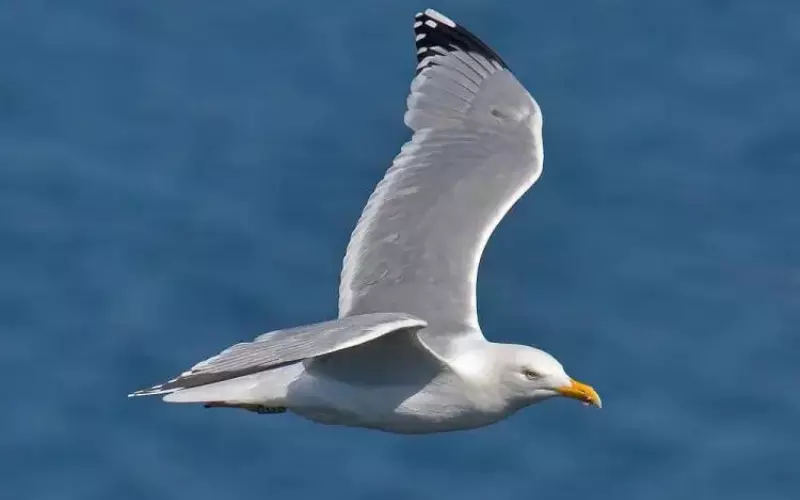
The Herring Gull bird has gone through a fascinating journey of evolution over millions of years. Long ago, the ancestors of Herring Gulls were not quite like the gulls we see today. They were more similar to shorebirds and lived near coastlines, catching fish and other small creatures to survive. As time passed, some of these shorebirds began to adapt to different habitats, such as lakes and rivers, which required changes in their physical traits and behaviours to thrive in these new environments.
One crucial adaptation that occurred in the evolution of Herring Gulls was the development of specialized beaks. The Herring Gull’s nib is sturdy and sharp, allowing it to scavenge for a broader range of food sources, including carrion and discarded human waste. This adaptation gave them an advantage, as they could find food more efficiently, leading to more remarkable survival and reproduction rates.
Another significant change in the evolution of Herring Gulls was the ability to adapt their nesting habits. Initially, these birds built simple nests on the ground, like many other shorebirds. However, as predators became more of a threat, some individuals made their nests in higher areas, such as cliffs or artificial structures. This adaptation protected their eggs and chicks better, increasing their survival chances.
The evolution of Herring Gulls has involved remarkable transformations over time. From their shorebird ancestors, they have developed specialized beaks to widen their food sources and have adapted their nesting behaviours to ensure the safety of their offspring. These changes have enabled Herring Gulls to thrive in various habitats and establish themselves as adept scavengers and skilled parents.
Classification of Herring Gull
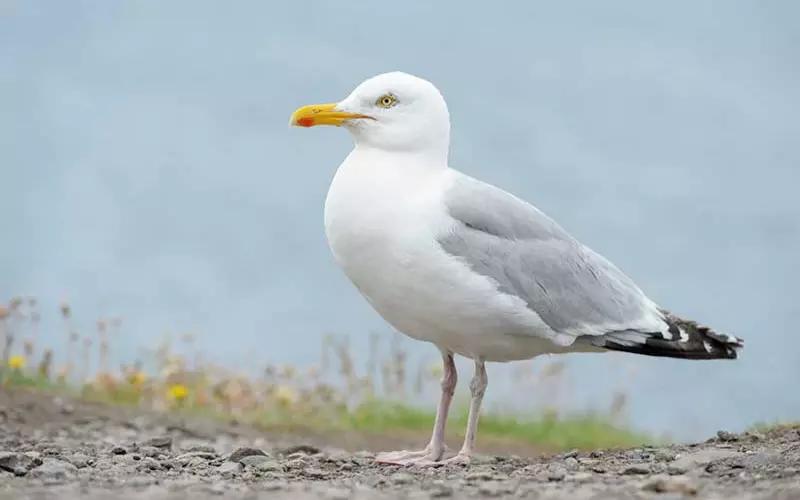
The herring gull bird belongs to a group called Larus argentatus. This group is part of the animal kingdom, the phylum Chordata, the class Aves, and the order Charadriiformes. Its scientific name, Larus argentatus, was given because its silver-coloured feathers resemble the gleam of the precious metal known as silver.
These gulls are medium to large-sized birds with a strong and sturdy body. Their wingspan can reach up to 5 feet, making them excellent flyers. The herring gull bird has a white body with grey wings and back. Its beak is yellow with a red spot, and it has webbed feet perfect for swimming and walking on sandy beaches.
Herring gulls are commonly found near coastal areas, lakes, and rivers. They are opportunistic feeders and can eat various foods like fish, insects, crustaceans, and garbage. They are known for their loud calls, which resemble high-pitched screams. These calls help them communicate with other birds and establish their territory.
The herring gull bird belongs to Larus argentatus and is part of the animal kingdom, phylum Chordata, class Aves, and order Charadriiformes. They have a white body with grey wings, a yellow beak with a red spot, and webbed feet. They are excellent fliers and can be found near coastlines, lakes, and rivers. Herring gulls are opportunistic feeders with loud calls to communicate with other birds.
Different Types of Herring Gull
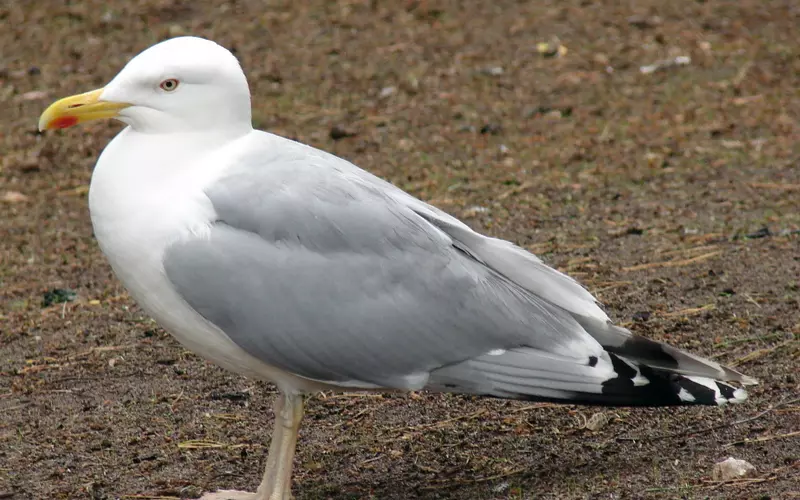
1. Western Herring Gull: Found in North America and Europe, these gulls have yellow legs, pinkish-grey bodies, and black-tipped wings. They are skilled scavengers often seen near coastal areas and garbage dumps.
2. Yellow-legged Herring Gull: Native to Europe, these gulls are recognized by their yellow legs, whiteheads, and pale grey feathers. They are adaptable and commonly found near coastal regions, lakes, and open farmyards.
3. American Herring Gull: Commonly seen in North America, these gulls have pink legs, slate-grey backs, and white heads with a red spot on their lower beak. They are social birds and can be found near coastlines, lakes, and inland garbage dumps.
4. Caspian Gull: Found in parts of Europe and Asia, these gulls have pinkish-grey bodies, yellow legs, and a distinctive white crescent-shaped patch on their wings. They are skilled hunters and often live near lakes, rivers, and coastal areas.
5. Armenian Gull: Native to Armenia and surrounding regions, these gulls have pale grey bodies, yellow legs, and a dark grey head with a white eye-ring. They are adaptable birds found near freshwater environments and urban areas.
6. Heuglin’s Gull: Found across Africa and the Middle East, these gulls have pale grey bodies, yellow legs, and a white tail with a black band. They are often seen near estuaries, coastal areas, and lakes, demonstrating excellent diving and fishing abilities.
7. Siberian Herring Gull: Native to Siberia in Russia, these gulls have pale grey bodies, yellow legs, and a pinkish beak with a red spot. They are migratory birds typically found near coastal regions, lakes, and rivers during the breeding season.
8. European Herring Gull: Commonly found in Europe, these gulls have yellow legs, grey backs, and a white head with pale yellow eyes. They are intelligent and adaptable birds, often seen near coastal cliffs, cities, and islands.
9. East Siberian Herring Gull: Native to eastern Russia, these gulls have yellow legs, pale grey bodies, and a distinctive pale yellow beak with a red spot. They primarily inhabit coastal regions, lakes, and rivers and are skilled at catching fish and marine invertebrates.
10. Vega Herring Gull: Predominantly seen in the Scandinavian region, these gulls have yellow legs, pale grey bodies, and a white head with a pale yellow eye. They are social birds near coastlines, cliffs, and urban areas.
Geographical Presence of Herring Gull
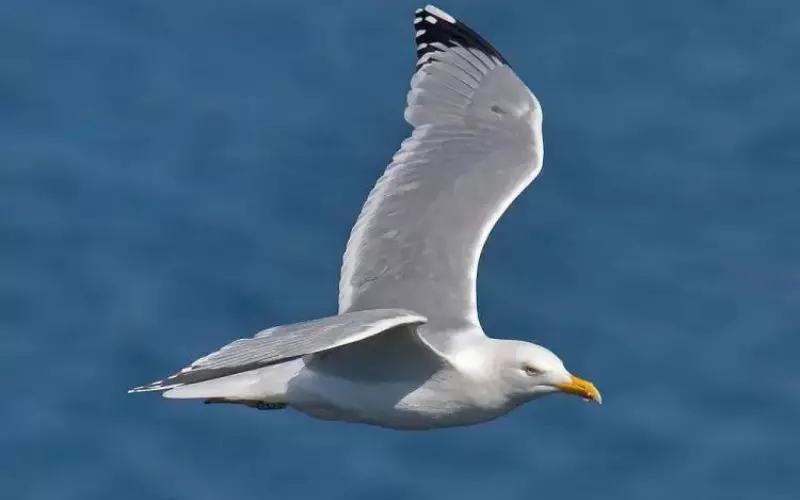
The Herring Gull bird can be found in Europe, North America, and Asia. In Europe, they are commonly seen along the coasts of the Atlantic Ocean and the Baltic Sea. In North America, they can be found along the shores of the Atlantic Ocean and the Great Lakes. In parts of Asia, they are found in countries like Russia, China, and Japan.
Herring Gulls prefer coastal habitats, such as rocky shores, sandy beaches, and harbours. The harbours are also often seen on islands and cliffs. These birds are well adapted to live near the sea and can be found near saltwater and freshwater habitats. They are known for their white head and body, grey wings, and yellow beak.
However, there are some regions where the Herring Gull is not found. They are not commonly seen in landlocked countries, as they prefer living near the coast. Therefore, countries far from the sea, such as Switzerland, Austria, and some parts of Central Asia, are not home to Herring Gulls. These birds also do not inhabit tropical regions; they thrive in colder climates.
The Herring Gull bird is found in regions like Europe, North America, and parts of Asia close to the coast. They prefer habitats near the sea, such as rocky shores and sandy beaches. However, they are not commonly observed in landlocked countries and tropical regions.
Scientific Name of Herring Gull
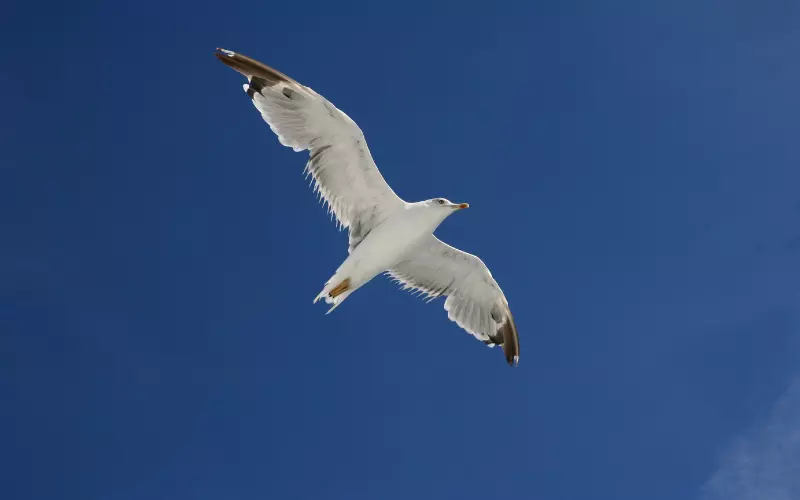
The scientific name of the Herring Gull bird is Larus argentatus. This magnificent bird belongs to the Laridae family and the genus Larus. Herring Gulls are large birds with a wingspan reaching up to 4.5 feet and a body length of around 22 to 26 inches.
These gulls are easily recognizable due to their white heads and tail feathers. Their bodies are mainly pale grey, with a yellow beak with a red spot on the lower half. Herring Gulls are expert scavengers and can be found near coastal areas, lakes, and rivers. They have a diverse diet that includes fish, crustaceans, insects, and even smaller birds or mammals.
Herring Gulls are highly adaptable and can be found in various habitats, from sandy beaches to cliffs and urban areas. They are excellent flyers, often seen soaring gracefully in the sky or perched on rocks and piers. These gulls are also known for their loud and distinctive calls, which can be heard from afar.
The scientific name for the Herring Gull bird is Larus argentatus. These large and beautiful birds are found near bodies of water and have a varied diet. Their unmistakable appearance and strong flying abilities make them fascinating to observe in their natural habitats.
Diet of Herring Gull
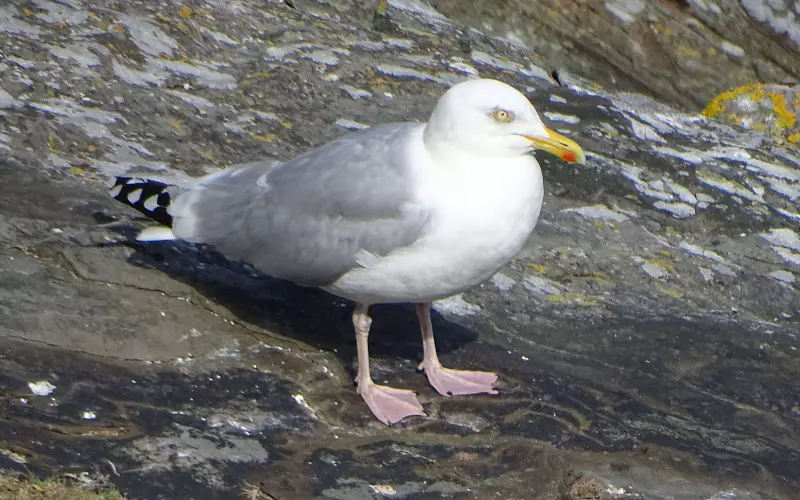
The Herring Gull bird has a diverse diet helps it find food quickly. It eats various types of food, such as fish, insects, shellfish, and even small mammals. Like us, they need a balanced diet to stay healthy and strong.
One essential part of a Herring Gull’s diet is fish. They are excellent divers and can catch fish from the water quickly. Fish provide essential nutrients like proteins and fats for their growth and energy. They also eat insects, which are a good source of protein as well.
Another part of their diet is shellfish, like crabs and mussels. They have strong beaks that help them break open the shells and extract the meat inside. The minerals in shellfish benefit a Herring Gull’s body and help keep their bones strong.
Lastly, Herring Gulls sometimes eat small mammals like mice and rats. They have sharp beaks that enable them to pick up and eat these tiny creatures. Although this is not their primary food source, it adds variety to their diet and provides different nutrients.
The Herring Gull’s diet includes fish, insects, shellfish, and small mammals. This diverse range of foods ensures a healthy, balanced diet. Herring Gulls can obtain all the necessary nutrients to survive and thrive in their environment by eating various foods.
Locomotion of Herring Gull

The Herring Gull bird moves around using a unique way called locomotion. Locomotion means how animals move from one place to another. The Herring Gull can move in three ways: by walking, flying, and swimming.
When the Herring Gull bird walks, it uses its feet to step one after another. It walks on the ground or rocks near the ocean to find food. These birds have long legs so that they can take significant steps. They use their wings for balance while walking and to make quick turns.
The Herring Gull bird flies in the sky when it wants to go far or find something to eat. It uses its wings to push the air and stay up in the air. Flying helps the Herring Gull bird travel long distances and catch fish from the ocean.
Lastly, the Herring Gull bird can swim in the water. Unlike other birds, it can float on the ocean’s surface and paddle its feet in the water. Swimming helps the Herring Gull bird find food that lives underwater, like fish or crabs.
The Herring Gull bird has different ways of moving around. It can walk on the ground or rocks, fly up in the sky, and even swim in the water. This helps the bird explore its surroundings, find food, and visit new places.
Social and Sexual Behaviour of Herring Gull

The herring gull bird is known for its interesting social and sexual behaviour. These birds are highly social and live together in colonies. Within these colonies, they engage in various activities such as nesting, feeding, and defending their territory. They communicate with each other using a variety of calls to convey different messages and warnings.
Regarding sexual behaviour, herring gulls form long-term pairs for breeding. Both the males and females participate in building the nest, with the female laying one to three eggs. The male and female take turns incubating the eggs, contributing to feeding and caring for the chicks once they hatch.
The male herring gull performs displays in mating rituals to attract the female. This display involves the male standing upright, puffing up his chest, and calling out loudly. The female then mimics the male’s movements and calls, showing her interest in mating.
Overall, the social and sexual behaviour of herring gulls is fascinating to observe. From their close-knit colonies to their courtship rituals, these birds display complex behaviours contributing to their survival and reproduction.
Reproduction and Lifecycle of Herring Gull
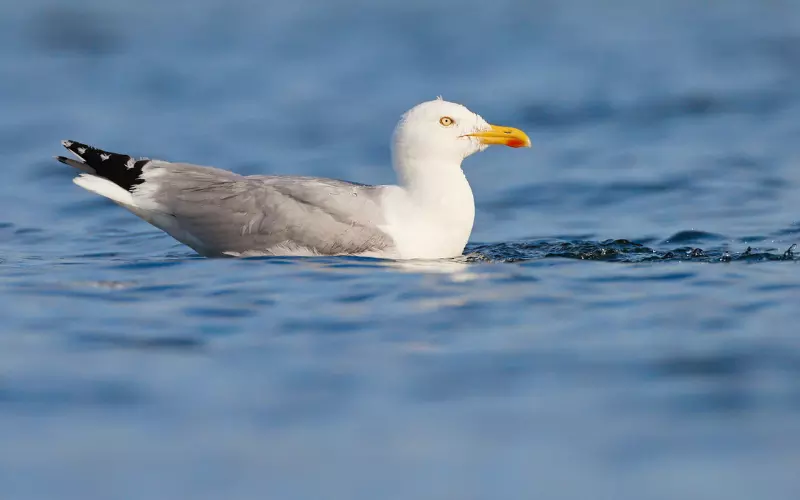
The herring gull bird goes through a remarkable reproductive process and life cycle. It all starts when two adult gulls find a suitable nesting spot, usually near the coast or on an island. The female gull lays two or three eggs, which are smooth and greenish. Both parents take turns warming the eggs by sitting on them. This helps the embryos inside the eggs to develop. After about three weeks, the eggs hatch and fluffy chicks emerge.
Once the chicks hatch, the parents take great care of them. They provide food by searching for fish, crustaceans, and insects near the water. The chicks increase and start to explore their surroundings. At around one month old, they learn how to fly. This is an exciting and crucial stage in their life cycle. The young gulls can now catch their food and become more independent.
As the chicks reach maturity, they begin to search for a partner. The males and females form long-term pair bonds and look for a suitable nesting site. They build nests on the ground, using grass and seaweed. The female lays her eggs in the nest, and both parents take turns incubating them. This cycle continues yearly as the herring gulls maintain their population and contribute to the beautiful coastal ecosystems they call home.
Threats to Herring Gull
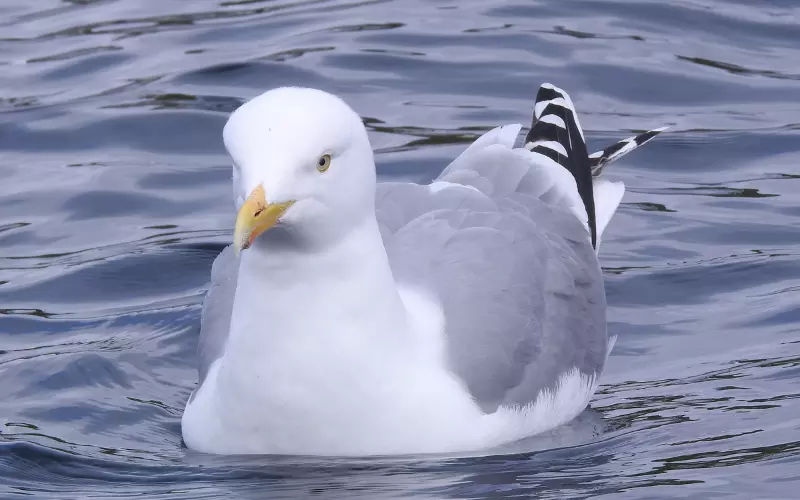
Herring gull birds are facing several threats that can harm their survival. One major threat to these birds is habitat loss. As humans continue to develop and expand their cities and towns, they often destroy the natural habitats of the herring gulls. This means that they lose their homes and places to find food. Without suitable habitats, the herring gull population can decline.
Another threat to herring gulls is pollution. Pollution can come from many sources, such as factories, cars, and beach litter. When the water, air, or land becomes polluted, it can harm the birds’ health. They may ingest toxins or come into contact with harmful chemicals, which can seriously affect their well-being.
Lastly, overfishing is a significant threat to herring gull birds. Herring gulls rely on fish as a primary food source, but when humans overfish the oceans, there is less fish for the gulls. This leads to malnutrition and difficulty in finding enough food to survive.
To help protect herring gull birds, humans need to be mindful of their actions. Preserving natural habitats, reducing pollution, and practising sustainable fishing methods are all steps that can be taken to ensure the herring gull population thrives. By understanding and addressing these threats, we can work towards a healthier and safer environment for these beautiful birds.
The population of Herring Gull
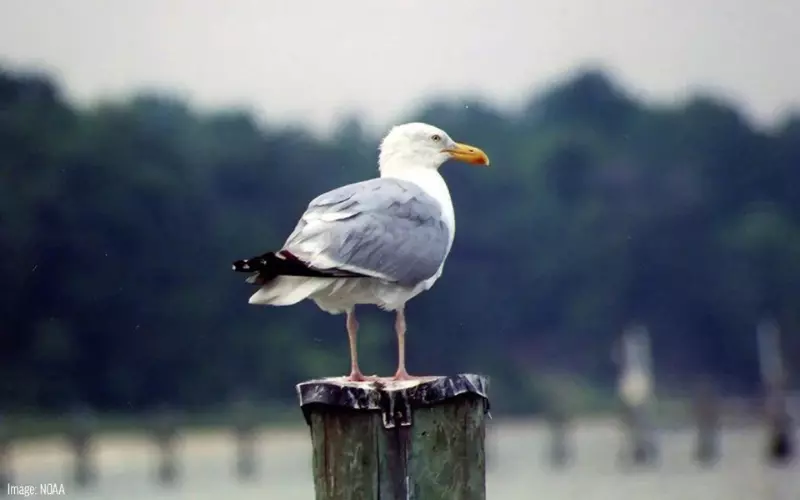
The Herring Gull bird is a common species in many parts of the world, especially along coastal areas. It is estimated that there are around 1.5 million breeding pairs of Herring Gulls globally. These birds are known for their large size, wingspan of about 1.5 meters, and striking white feathers, grey wings, and yellow bill. The Herring Gull is a versatile bird that can adapt to various habitats, such as cliffs, dunes, and even urban areas.
Unfortunately, if the Herring Gull were to become extinct, it would mean that no more of these birds exist worldwide. Extinction happens when a species cannot survive and reproduce for various reasons, such as habitat destruction, pollution, or changes in their food sources. Humans must take measures to protect the Herring Gull and other bird species from extinction. This can be done by preserving their natural habitats and reducing environmental pollution. By taking these actions, we can help ensure that future generations can enjoy the presence of these beautiful birds in our world.
Conclusion
The Herring Gull is a fascinating bird in many parts of the world. Its history can be traced back thousands of years, and it has adapted well to living in various habitats. This classification as a seabird is due to its muscular wings, beak, and excellent diving skills. The Herring Gull is a large bird with a white head and body and grey wings with black tips.
With a wingspan of about 4 feet, the Herring Gull is known for its impressive size. It is regarded as one of the largest species of gulls. These birds are often seen near coastlines, lakes, and garbage dumps, where they can find plenty of food. Herring Gulls are opportunistic feeders and can eat anything from fish and small mammals to garbage and scraps from humans.
Improper waste disposal has increased the Herring Gull population in some areas, which can cause a nuisance. However, it is essential to remember that these birds play a vital role in the ecosystem. They help control pests and are indicators of the health of the surrounding environment. Therefore, it is crucial to respect and preserve their natural habitats while enjoying the beauty and wonder of these magnificent creatures.
The Herring Gull is a remarkable animal that has adapted to various environments. Its history, size, habitat, and classification as a seabird make it a unique and fascinating species to study. By understanding and appreciating these birds, we can work towards protecting their habitats and ensuring their survival for future generations to admire. Let us cherish and respect all animals, including the Herring Gull.
Frequently Asked Questions about Herring Gull (FAQ’s)
What is a Herring Gull bird?
The Herring Gull, scientifically known as Larus argentatus, is a large, predatory seabird commonly found near coastal regions.
What is the average size of a Herring Gull?
Herring Gulls are typically around 55-66 cm (22-26 inches) long, with a wingspan of 124-150 cm (49-59 inches).
Where are Herring Gulls commonly found?
Herring Gulls are found in coastal areas of North America, Europe, and some parts of Asia.
What is the diet of a Herring Gull?
Herring Gulls are opportunistic feeders with varied diets, including fish, crustaceans, insects, small mammals, and even garbage.
How do Herring Gulls communicate with each other?
Herring Gulls communicate through various calls and vocalizations, including calls for food, courtship, and territorial disputes.
Are Herring Gulls migratory birds?
Herring Gulls are migratory birds, although some populations may stay in the same area year-round.
How long have Herring Gulls lived?
The average lifespan of a Herring Gull is around 20-30 years, but they can live up to 40 years in favourable conditions.
Do Herring Gulls mate for life?
Herring Gulls are typically monogamous birds, with pairs often mating for life.
How do Herring Gulls build their nests?
Herring Gulls build nests using various materials, including grass, seaweed, and debris, often on the ground or cliffs.
Are Herring Gulls aggressive?
While Herring Gulls can exhibit aggressive behaviour, especially when protecting their nests or searching for food, they are generally not aggressive towards humans.
Can Herring Gulls swim?
Herring gulls are strong swimmers and are frequently seen floating on water surfaces.
Do Herring Gulls have any predators?
Herring Gull eggs and chicks are vulnerable to predation from larger birds, such as ravens and crows, and mammals like foxes and raccoons.
Do any laws protect Herring Gulls?
In many countries, Herring Gulls are protected under wildlife laws, making harming or disturbing them or their nests illegal.
Can Herring Gulls be kept as pets?
While keeping a Herring Gull as a pet is technically possible, it is not recommended due to their specialized needs and the legal requirements surrounding their possession.
How do Herring Gulls adapt to urban environments?
Herring Gulls have shown remarkable adaptability to urban areas, often nesting on rooftops or parks and feeding human-generated food waste.

Hey there, I’m Kristen Haudenschild! I’m like a superhero for animals and people.
I work as a Dependable Hard Working Supervisor, which means I help both people and animals grow and learn. I did my school at OdySea Aquarium and Georgia Southern University in Tempe, Arizona. That’s where I learned all about animals, and guess what? I’m fascinated by them!
I even write cool articles about animals. My job history includes being an Animal Trainer and a Marine Mammal Trainer II at OdySea Aquarium. I’ve also been a Senior Animal Care Specialist and an Animal Care Specialist 2.
I love exploring animals and am always ready to help others learn more about them. So, if you ever need info about animals, give me a shout!

